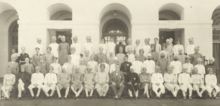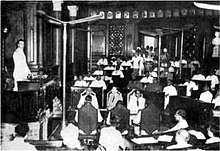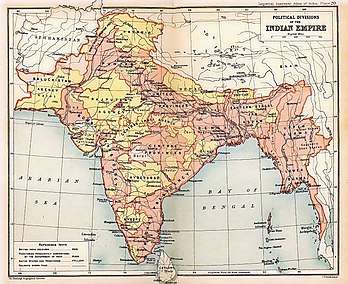Chamber of Princes
The Chamber of Princes (Narendra Mandal) was an institution established in 1920 by a royal proclamation of King-Emperor George V to provide a forum in which the rulers of the princely states of India could voice their needs and aspirations to the colonial government of British India. It survived until the end of the British Raj in 1947.[1]

| Princely state |
|---|
| Individual residencies |
|
| Agencies |
|
| Lists |
Overview
The Chamber of Princes was established in 1920, by King-Emperor George V's proclamation on 23 December 1919, after the Government of India Act 1919 was given royal assent. The creation of the chamber followed the abandonment by the British of their long-established policy of isolating the Indian rulers from each other and also from the rest of the world.[2]
The Chamber first met on 8 February 1921 and initially consisted of 120 members. Of those, 108 from the more significant states were members in their own right, while the remaining twelve seats were for the representation of a further 127 states. That left 327 minor states, which were unrepresented. Also, some of the more important rulers like the Maratha-ruled states of Baroda State, Gwalior State and Holkar State declined to join it .[3]
The Chamber of Princes usually met only once a year, with the Viceroy of India presiding, but it appointed a Standing Committee which met more often. The full Chamber elected from its princely ranks a permanent officer styled the Chancellor, who chaired the Standing Committee.[3]
The chamber convened at Sansad Bhavan. The hall is used as parliament's library today.
Concerns about post-independence constitution

On 12 March 1940, the Chamber resolved:
The Chamber of Princes, while welcoming the attainment by India of its due place among the Dominions of the British Commonwealth under the British Crown, records its emphatic and firm view that, in any future constitution for India, the essential guarantees and safeguards for the preservation of the sovereignty and autonomy of the States and for the protection of their rights and interests arising from treaties, and engagements and sanads or otherwise, should be effectively provided and that any unit should not be placed in a position to dominate the others or to interfere with the rights and safeguards guaranteed to them, and that all parties must be ensured their due share and fair play; And that, in any negotiations for formulating a constitution for India, whether independently of the Government of India Act 1935, or by revision of that Act, representatives of the States and of this Chamber should have a voice proportionate to their importance and historical position.[4][5]
Chancellors

| Name | Title | Years |
|---|---|---|
| Major-General His Highness Sir Ganga Singh | Maharaja of Bikaner | 1921–1926 |
| Adhiraj Major-General His Highness Sir Bhupinder Singh | Maharaja of Patiala | 1926–1931 |
| Colonel His Highness Sir K.S. Ranjitsinhji | Maharaja of Nawanagar | 1931–1933 |
| Colonel His Highness Sir K.S. Digvijaysinhji | Maharaja of Nawanagar | 1933–1943 |
| Yadavindra Singh | Maharaja of Patiala | 1943-1944 |
| Hajji Major-General His Highness Sir Hamidullah Khan | Nawab of Bhopal | 1944–1947 |
See also
- Durbar (court)
- List of Indian princely states
- Salute state
References
- Vapal Pangunni Menon (1956) The Story of the Integration of the Indian States, Macmillan Co., pp. 17-19
- Barbara N. Ramusack, The Princes of India in the Twilight of Empire: Dissolution of a Patron-client System, 1914–1939 (Ohio State University Press, 1978) p. xix
- John Allan, Wolseley Haig, Henry Dodwell, The Cambridge Shorter History of India (1969), p. 1065
- Nicholas Mansergh, Documents and Speeches on British Commonwealth Affairs, 1931-1952 (Oxford University Press, 1953) p. 606
- Verma, Chamber of Princes, 1921-1947, p. 170
Further reading
- S. M. Verma. Chamber of Princes, 1921-1947 at Google Books. ISBN 81-85135-44-4
- Proceedings of the Meetings of the Chamber of Princes (Narendra Mandal) Held at New Delhi on 14 and 15 October 1943 at Google Books
- R. P. Bhargava, The Chamber of Princes (Northern Book Centre, 1991, 351 pp.) ISBN 81-7211-005-7
- Barbara N. Ramusack, The Princes of India in the Twilight of Empire: Dissolution of a Patron-client System, 1914–1939 (Ohio State University Press, 1978)
- Ian Copland, Princes of India in the Endgame of Empire, 1917-1947 (Cambridge University Press, Cambridge Studies in Indian History & Society, 2002)
External links
![]()